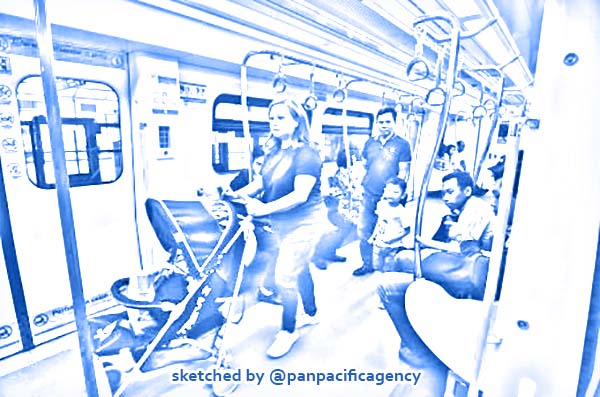LRT Jakarta to start commercial operations in December

Passengers ride on the LRT Jakarta during a trial run at the Velodrome Station in East Jakarta on Nov. 21. The Jakarta administration will officially commence commercial operations for the LRT Jakarta starting Dec. 1, when passengers will be required to pay Rp 5,000 per trip. (Antara/Fakhri Hermansyah). Sketched by the Pan Pacific Agency.
JAKARTA, Nov 22, 2019, The Jakarta Post. After a five-month trial run, the first phase of the LRT Jakarta, which runs from Kelapa Gading in North Jakarta to Velodrome in East Jakarta, will commence commercial operations on Dec. 1, although analysts have cast doubts on its significance in alleviating traffic congestion, The Jakarta Post reported.
City-owned PT LRT Jakarta president director Wijanarko said that starting December passengers would be required to pay Rp 5,000 (35 US cents) per trip, the fare that had been set by the city administration and city council in March.
The operational hours will remain the same as in the trial runs, 5:30 a.m. to 11 p.m. daily.
“We have also equipped our stations with bicycle parking facilities. Hopefully, all this can provide comfort to the community and convenience for prospective passengers,” said Wijanarko at the Velodrome LRT Station on Thursday.
The construction project began in September 2015 and was initially expected to be ready by early 2018, in time for the Asian Games. However, because of funding and land-acquisition issues, it failed to meet the deadline.
The other LRT stations on the 5.8-kilometer-long route are Equestrian and Pulomas in East Jakarta and South Boulevard, North Boulevard and Pengangsaan Dua in North Jakarta.
The travel time from Velodrome to Pegangsaan Dua Station will be about 13 minutes with train speeds of 55 kilometers per hour with a gap between train arrivals of 10 minutes.
Operational and service general manager Aditia Kesuma Negara said LRT Jakarta had served more than 1 million passengers during its public trial from June 11 until Nov. 17, with an average passenger capacity of 6,528 per day.
“LRT has served a total of 1.04 million customers during the trials, with a constantly growing capacity every month since the operations of Pegangsaan Dua Station in September and the 10F Transjakarta as an integrated feeder route in October,” said Aditia.
The new Transjakarta feeder service operating from Pegangsaan Dua Station to Sunter Kelapa Gading in North Jakarta via Artha Gading Mall and Mall of Indonesia boosted average daily LRT passenger numbers to 7,511 in early November.
In addition all LRT stations have been connected to their respective feeder routes by Transjakarta bus rapid transit and angkot (public minivans).
“We are optimistic that with the integration, LRT services can provide a seamless transportation experience with a wider mileage range,” Aditia added.
Director of finance and business development, Rudy Hartono, said besides using a Single Journey Trip (SJT) card, LRT passengers can also pay their fares by tapping e-money cards issued by its bank partners.
“Our realistic capacity target at the beginning [of commercial operations] is still the same as during the trials, or approximately 7,000 passengers. But in the long run, we hope to reach 14,000 per day,” he said.
To increase commuter comfort, he added, 35 business partners, mostly food and beverage retailers, were ready to serve LRT passengers in the stations.
City-owned developer PT Jakarta Propertindo (Jakpro), which is in charge of the LRT project, expects to start work on the construction of the first half of the LRT second phase (LRT Phase 2A) next year.
Project director Iwan Takwin said LRT Phase 2A connecting Kelapa Gading Station with the Jakarta International Stadium (JIS) was expected to start commercial operations in 2022.
However, Phase 2A construction will not run alongside Phase 2B, the route that will connect Velodrome Station with Manggarai in South Jakarta. The company and the Jakarta administration will first conduct feasibility studies and basic designs for the construction of Phase 2B as included in the regional strategic plan.
The second phase of the LRT project is projected to cost a total of Rp 7 trillion. Phase 2A will be 8 kilometers, while Phase 2B will be 6 kilometers. Thus, the total length of the Jakarta LRT track after the construction of the second phase will be about 20 kilometers.
The first phase of the LRT construction cost Rp 1.08 trillion per kilometer.
Iwan, however, declined to elaborate on the operational costs of the service during the five-month trials when passengers could ride on the LRT for free.
Transportation observer from the Indonesian Transportation Society, Djoko Setijowarno, doubted that the first phase would attract many passengers, saying that the service would serve its purpose if the construction of further routes was completed.
“It will be effective if the project continuation is completed, especially the routes toward Dukuh Atas and Tanah Abang [in Central Jakarta], so that passengers will not need to switch to Transjakarta buses,” said Djoko.
Experts have criticized the short length of LRT Jakarta pointing out that without the support of other public transportation modes or expanded routes it would not be attractive for commuters.
Paradhita Tan, 32, a housewife living in Kelapa Gading, said she had been taking her fourth-grader son to his school in Central Jakarta by both LRT and Transjakarta during the trial runs.
Although she said the journey was shorter than traveling by car the city administration needed to speed up the construction of the next phase to make it more accessible.